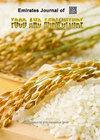Phenolic screening and anticancer potential of various wild savory extracts
IF 0.7
4区 农林科学
Q3 AGRONOMY
引用次数: 0
Abstract
Cancer is one of the leading causes of death in our age. In addition to the treatments used in cancer, plants are frequently used in complementary or alternative approaches. Plants of the genus Satureja are used world wide for various purposes, primarily as complementary therapies. For this purpose, in this study, the antioxidant potential and phenolic content of the Satureja cuneifolia plant, which is frequently consumed as a spice and tea among the public, and its cytotoxic and apoptosis-inducing effects on cancer cells were tried to be revealed. The cytotoxic effect of the extracts prepared with three different solvents (methanol, ethanol and water) was determined by the MTT test in colorectal cancer (DLD1) and promyelocytic leukaemia cell lines (HL60). Then the expression levels of five apoptotic gene regions (apaf-1, bax, bcl2, card4, casp3 and tp53) were evaluated with Real-Time PCR. The antioxidant potential was determined via the DPPH test, and HPLC was used to screen for phenolic substances. As a result, it was determined that the extracts have cytotoxic effects and have a variable but positive effect on pro-apoptotic gene expressions. When the antioxidant potential was evaluated, it was determined that the methanolic extract had a more radical scavenging effect (IC50: 105.02±0.034 µg/ml). In conclusion, the cytotoxic and apoptosis-inducing potentials of the extracts obtained from the S. cuneifolia plant were revealed for the first time upon DLD1 and HL60 cell lines in this study. This study is a pioneer for future studies in cancer therapy. Keywords: Apoptosis; qRT-PCR; Spice; Turkey; Wild savory各种野生香料提取物的酚类筛选及其抗癌潜力
癌症是我们这个时代死亡的主要原因之一。除了用于癌症的治疗外,植物还经常以互补或替代的方式使用。Satureja属植物在世界各地被用于各种目的,主要是作为补充疗法。为此,在本研究中,试图揭示楔形萨图雷植物的抗氧化潜力和酚类含量,该植物在公众中经常被用作香料和茶,以及其对癌症细胞的细胞毒性和凋亡诱导作用。通过MTT试验测定了用三种不同溶剂(甲醇、乙醇和水)制备的提取物对大肠癌细胞株(DLD1)和早幼粒细胞白血病细胞株(HL60)的细胞毒性作用。然后用实时PCR检测5个凋亡基因区(apaf-1、bax、bcl2、card4、casp3和tp53)的表达水平。通过DPPH测试测定抗氧化潜力,并使用HPLC筛选酚类物质。结果,确定提取物具有细胞毒性作用,并且对促凋亡基因表达具有可变但积极的作用。当评估抗氧化潜力时,确定甲醇提取物具有更大的自由基清除作用(IC50:105.02±0.034µg/ml)。总之,在本研究中,首次揭示了从楔叶植物中获得的提取物对DLD1和HL60细胞系的细胞毒性和诱导细胞凋亡的潜力。这项研究是癌症治疗未来研究的先驱。关键词:细胞凋亡;qRT-PCR;香料土耳其野生咸味
本文章由计算机程序翻译,如有差异,请以英文原文为准。
求助全文
约1分钟内获得全文
求助全文
来源期刊

Emirates Journal of Food and Agriculture
AGRONOMYFOOD SCIENCE & TECHNOLOGY&nb-FOOD SCIENCE & TECHNOLOGY
CiteScore
1.80
自引率
0.00%
发文量
18
期刊介绍:
The "Emirates Journal of Food and Agriculture [EJFA]" is a unique, peer-reviewed Journal of Food and Agriculture publishing basic and applied research articles in the field of agricultural and food sciences by the College of Food and Agriculture, United Arab Emirates University, United Arab Emirates.
 求助内容:
求助内容: 应助结果提醒方式:
应助结果提醒方式:


